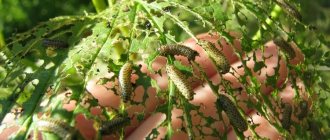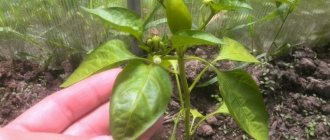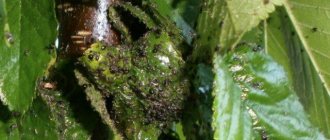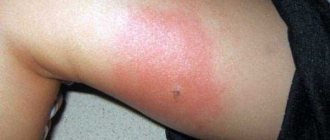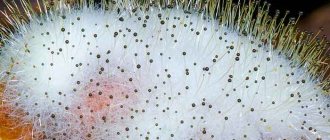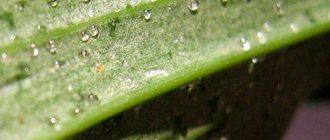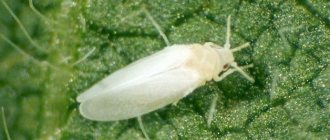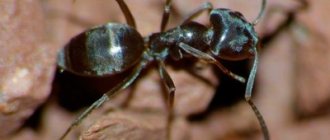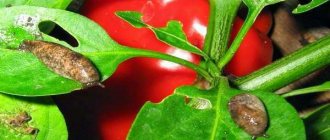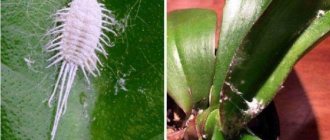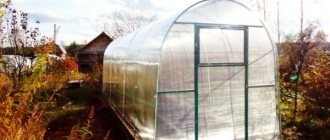Unfortunately, like most cultivated plants, viburnum is a source of food for black aphids. These insects can occupy the plant to the point where the stems appear completely black. Aphids feed on plant juices and also transmit viral diseases through microcracks in the stem. All this reduces the amount of harvest, leads to weakening, withering of viburnum bushes, and even to their complete drying out and death.
Black aphids attack not only viburnum, but also most fruit trees and shrubs, such as cherries, cherries, and ornamental plants, and can move between them, infecting the entire garden. The affected plant is easy to notice - its leaves are deformed, swollen, curled, and covered with dark spots. Such bushes dry out quickly and do not produce the expected harvest. The dusty, brownish coating of the feces of these parasites contributes to the development of sooty fungus, mold and rot. In general, the aphid population can delay plant growth for 30 days.
Aphids on viburnum: possible insect pests of viburnum trees
The tree that I love the most is the black aphid. She literally lives on it. At the end of summer and beginning of autumn, adult specimens begin laying eggs in the bark and space near the flower buds. This is exactly how future larvae overwinter. With the arrival of spring, the larvae begin to hatch, move onto young foliage and feed on its juices. This causes curling, deformation and the appearance of black spots on the foliage. The older the individual, the more harm it causes. Because over time, aphids move to young branches, which can cause them to dry out. Towards the end of the spring period, individuals with wings begin to appear. These are females and males who can already begin to reproduce. You need to start fighting aphids on viburnum at the moment when the foliage is already beginning to bloom. The pest insect can move to other crops, but it will live specifically on viburnum. During one growing season of a tree, the pest will hatch several generations.
How to spray roses, currants, apple trees with ammonia against aphids
The ammonia has already been diluted, now all that remains is to spray the damaged rose bushes and trees. Spray roses only on buds and young shoots. Aphids accumulate on young leaves. It must be thoroughly treated with a solution of ammonia. For processing it is best to use a hand sprayer.
When processing currants, you need to unroll the curled leaves so that the ammonia gets to the pests.
Ammonia is a nitrogen-containing fertilizer. Nitrogen acts on the plant as a growth stimulator. After applying nitrogen, plants increase their green mass. Therefore, it is best to use ammonia against aphids during the period of active growth of garden crops. The ideal time is early spring from April to mid-May. During the period of ripening of fruits and flowering of decorative flowers, it is better to choose another method to combat insect pests.
Roses and other crops should be sprayed several times a season. After spraying, the garden will live without insects for approximately 10 days to three weeks. After the appearance of the first winged individuals, the treatment should be repeated in order to avoid the spread of numerous offspring of insects.
Safety when spraying the garden with ammonia solution
Ammonia is not as safe for humans as you might think. Inhaling ammonia vapor can not only cause poisoning, but also cause serious burns to the trachea. If you breathe ammonia for a long time, you can completely block the respiratory center. Stopping breathing leads to death. So take care of personal safety equipment when you spray your garden or vegetable garden.
Dilution of ammonia for treating the garden against aphids
Goggles, gloves and a mask will help avoid unpleasant consequences. If the solution accidentally gets on the skin of your face or hands, you should wash with running water.
It is advisable to spray on a sunny day. Lack of rain will give a better chance of a positive result. If there is a strong wind outside, refuse to spray garden crops so that the ammonia solution does not get on you.
Aphids on viburnum: how to treat? Effective means
Such remedies for aphids on viburnum are sold in a highly concentrated liquid format. Therefore, before use, the required amount of concentrated liquid must be diluted in water so that the concentration is not so high. Usually it is diluted in ten liters of water, or simply in a bucket. During the mixing and use procedure, you must protect yourself with: 1) Safety glasses; 2) Latex gloves; 3) Protective apron. The processing must be carried out strictly, either in the morning or in the evening. You also need the weather to be dry and windless.
Among the most well-known and effective drugs are: 1) Actellik; 2) Inta-Vira; 3) Karbofos; 4) Tanrek; 5) Prestige; 6) Decis; 7) Aktara; Spark; 9) Fufanon; 10) Fitoverm.
2) Inta-Vira; 3) Karbofos; 4) Tanrek; 5) Prestige; 6) Decis; 7) Aktara; Spark; 9) Fufanon; 10) Fitoverm.
The decision in choosing a drug, of course, remains yours. But all the drugs from the presented list act instantly, the aphid dies within seven days, and continues to retain its effects for up to twenty days. Experienced gardeners recommend treating the bush with nitrophen paste, even before the buds open. If the viburnum has already begun to bloom, then it can be treated with any insecticidal preparation by spraying.
Diseases of Buldenezh
In addition to the fact that viburnum Buldenezh suffers from insects, it can also suffer from fungal or viral diseases.
These include:
- powdery mildew - an illness caused by a fungus. Develops in damp and cold environments. It is expressed as a white powdery coating that becomes gray over time. Brown spots form on the underside of the foliage. The leaves dry out and fly off. Control measures include collection and disposal of dry leaves, sanitary pruning of bushes in the fall or spring, treatment of plants with a 1% solution of Bordeaux mixture, 3% solution of copper sulfate, 7% solution of iron sulfate. Among the folk remedies, an infusion of field sow thistle (1 kg per 3 liters of water, leave for 8–10 hours), an infusion of garlic or onion (200 g of husk per 10 liters of water, leave for 5–10 hours) is suitable;
- ascochyta blight - fungal disease. It forms gray spots surrounded by brown edges on all parts of the plant. On the underside of the leaves these spots are gray-green. By autumn they crack, dry out and fall out. Small cankers form on the branches. To cure viburnum from ascochyta blight, you need to destroy regularly fallen foliage, loosen the soil around the trunk, and before budding, spray the plants with a 1% solution of Bordeaux mixture, the HOM preparation, colloidal sulfur, copper sulfate, etc.;
- cercospora - differs from ascochyta blight in that the gray spots that appear have an orange border. The disease begins to develop from the lower leaves and rises upward. The main source of infection is weeds, fallen leaves, and plant debris. Treatment for cercospora blight is the same as for ascochyta blight;
- gray rot - infects viburnum leaves in the form of brown spots, which enlarge over time, dry out and crack. Most often it occurs on foliage damaged by leaf beetle or hail. In damp conditions, mycelium appears on the spots in the form of a gray coating with a large number of spores, which fly to healthy plants and infect them. The Vectra fungicide (2.7 ml per 10 liters of water), a solution of copper oxychloride (40 g per 10 liters of water), etc. will help cope with this disease;
- viral diseases cause yellowing and mosaic leaves. Viruses are carried by insects and also infect viburnum when pruning bushes with contaminated garden tools. Sick plants suffer because of this and die very quickly. The only method of preventing mass infection is the complete destruction (burning) of the entire bush.
Important! It is necessary to use chemicals strictly following the instructions for use attached to them.
Aphids on viburnum: fighting with folk remedies
You need to fight aphids in every possible way. There are a lot of folk remedies, they are proven and reliable. With their help, you can do without chemical options.
First way
To get rid of aphids on viburnum and emerge victorious from the battle with aphids, you need to cut off the shoots that grow closest to the roots at the end of the autumn period. After all, it is in that place that eggs are laid in the winter. With the arrival of spring, when the bush begins to bloom, you need to water the earthen space around the plant with hot, boiled and clean water.
Second way
It involves attracting insect hunters who eat aphids. For example: 1) Ladybug; 2) Lacewings and their larvae; 3) Hoverflies. You can attract such insects with the help of plant crops: 1) Mustard; 2) Tansy; 3) Dill; 4) Clover; 5) Angelica; 6) Yarrow; 7) Dandelions; Buckwheat; 9) Sweet clover; 10) Navel and so on.
For example: 1) Ladybug; 2) Lacewings and their larvae; 3) Hoverflies. You can attract such insects with the help of plant crops: 1) Mustard; 2) Tansy; 3) Dill; 4) Clover; 5) Angelica; 6) Yarrow; 7) Dandelions; Buckwheat; 9) Sweet clover; 10) Navel and so on.
Third way
By spraying the solution on onion peels. After all, this pest cannot stand this smell and will immediately prefer to destroy the location. What can be prepared from: 1) Two hundred grams of onion peel; 2) Five hundred grams of wood ash (the ash must be from clean wood, that is, not after it has been painted, varnished or glued); 3) Two hundred grams of tobacco powder; 4) Ten liters of clean water. All ingredients must be mixed thoroughly, and only then poured with water. All this must also be mixed in water. For the mixture to infuse, it needs to be left for about five days.
Before use, you need to grate one hundred grams of laundry soap on a fine grater and mix thoroughly again. Before spraying, strain. At the end of the spring period, the plant needs to be sprayed even before its first foliage blooms, or when it begins to bloom. The procedure must be carried out every seven days, until the pests are completely destroyed.
Fourth method
Soap and spice solution. What to prepare from: 1) Wood ash (ash should be from clean wood, that is, not after painted, varnished or glued); 2) Cinnamon; 3) Red pepper; 4) Black pepper; 5) A mixture of water with laundry or baby soap. All ingredients must be mixed in the required proportions. Next, pour into a barrel with a sprayer and begin processing. It is recommended to carry out the first treatment against aphids on viburnum in the spring. Then repeat every thirty days with an interval of seven to fourteen days.
Fifth method
Garlic tincture. You need to take two hundred grams of garlic and crush it. Pour the raw material with one liter of water and put it on fire. The mixture needs to simmer for about thirty minutes. After this, cover with a lid and let the solution sit. This will take approximately five days. Before the spraying procedure, you need to strain the solution and add one third of a piece of laundry or baby soap.
Sixth method
The next way to get rid of aphids on viburnum is a tobacco tincture. You need to take two hundred grams of tobacco powder. Pour the raw material with one liter of water and put it on fire. The mixture needs to simmer for about thirty minutes. After this, cover with a lid and let the solution sit. This will take approximately five days. Before the spraying procedure, you need to strain the solution and add one third of a piece of laundry or baby soap.
Seventh method
Tincture on pine paws. You need to take two hundred grams of pine needles. Pour the raw material with one liter of water and put it on fire. The mixture needs to simmer for about thirty minutes. After this, cover with a lid and let the solution sit. This will take approximately five days. Before the spraying procedure, you need to strain the solution and add one third of a piece of laundry or baby soap.
Eighth method
A solution based on potato tops. You need to take the required amount of potato tops and chop them. Next, pour in ten liters of clean water. Put on the fire, the whole thing should boil for thirty minutes. For control purposes, spraying is carried out every seventy-two hours. For preventive purposes, the frequency should be reduced to once every fourteen days. Cannot be used immediately. The longer the mixture-solution is infused, the higher its concentration will be.
Ninth method
A solution based on tomato tops. You need to take the required amount of tomato tops and chop them. Next, pour in ten liters of clean water. Put on the fire, the whole thing should boil for thirty minutes. For control purposes, spraying is carried out every seventy-two hours. For preventive purposes, the frequency should be reduced to once every fourteen days. Cannot be used immediately. The longer the mixture-solution is infused, the higher its concentration will be.
Tenth method
Solution against aphids on viburnum based on marigold tops. You need to take the required amount of marigold tops and chop them. Next, pour in ten liters of clean water. Put it on the fire, it all should boil for thirty minutes. For control purposes, spraying is carried out every seventy-two hours. For preventive purposes, the frequency should be reduced to once every fourteen days. Cannot be used immediately. The longer the mixture-solution is infused, the higher its concentration will be.
Nature to the rescue
To protect viburnum from aphids, use natural enemies - predators, as well as special plants:
- ladybugs, lacewings, wasps, bedbugs and many other insects feed on aphids. Therefore, if you see larvae on viburnum that look like Colorado beetles, do not remove them - these are ladybird larvae;
- sparrows, tits, skrovets, and other small birds will also help destroy aphid settlements. Lure them with feeders, drinkers and birdhouses;
- plant onions, garlic, herbs - thyme, basil, etc. under the bush. Their smell is unbearable for aphids, so with a high probability the insects will not want to settle nearby. Marigold and pyrethrum are also suitable for this purpose;
- Some beautiful flowers will not only decorate the garden, but will also attract most of the insects. These are calendula, poppies, cosmos, mallow, etc.
Chemicals
It is necessary to combat aphids on viburnum with the help of pesticides in early spring. Many gardeners are puzzled as to which product is best to use. Experts recommend using systemic agents in such a situation. Absorbed into the plant tissue, they negatively affect insects that feed on the sap of this crop.
Chemicals for killing aphids
It is preferable to use drugs based on neonicotinoids or organophosphorus compounds to combat aphids. These include:
Before the buds appear, the viburnum bush can also be treated with Nitrafen infusion (200 g of product per 1 liter of water). We should also not forget that one of the main reasons for the spread of aphids is ants that feed on the pest’s secretions. Therefore, similar means are used when an ant nest is discovered in a personal plot.
